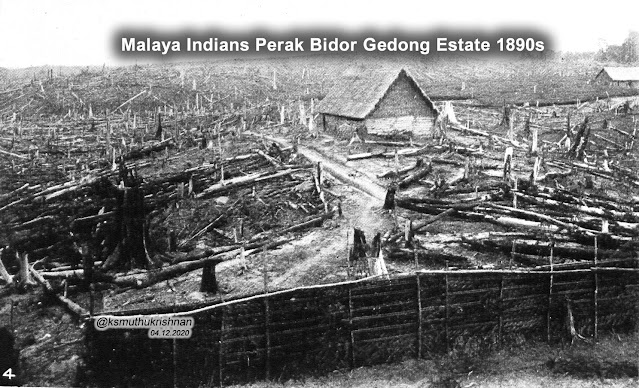1860-ஆம் ஆண்டுகளில் சுங்கை சிப்புட் ஹேர்வூட் தென்னைத் தோட்டம் உருவாக்கப்பட்டது. அங்கே ஒரு தேங்காய் எண்ணெய் தயாரிப்பு ஆலையும் உருவானது. ஏறக்குறைய 40 தமிழர்கள்; 50 சீனர்கள்; அந்தத் தொழிற்சாலையில் வேலை செய்தார்கள். வருடத்தைக் கவனியுங்கள். 1860-ஆம் ஆண்டுகள்.
Sungai Siput Hearwood Coconut Plantation was established in the 1860s. A coconut oil production factory was also set up there. About 40 Tamils and 50 Chinese worked in that factory. Note the year. 1860s.
1820-ஆம் ஆண்டுகளில் பேராக் மாநிலத்தில் ஈய உற்பத்தி செழிப்புற்ற காலம். சுங்கை சிப்புட் ஹேர்வூட் தோட்டத்திற்கு அருகிலும் ஈயச் சுரங்கங்கள் தோன்றின. ஹேர்வூட் தென்னைத் தோட்ட ஆலையில் வேலை செய்த சீனர்கள், ஈயச் சுரங்கங்களில் வேலை செய்வதற்கு இடம் பெயர்ந்தார்கள்.
1820s were the heydays of tin production in the state of Perak. Many tin mines mushroomed adjacent to Sungai Siput Hearwood estate. The Chinese, who worked at the Hearwood coconut plantation, moved to work in the tin mines.
அதனால் ஹேர்வூட் தென்னைத் தோட்டத்தில் ஆள் பற்றாக்குறை. ஆகவே தமிழர்கள் அழைத்து வரப் பட்டார்கள். 1866-ஆம் ஆண்டில் நடந்த நிகழ்ச்சி.
Hence the shortage of manpower in the Hearwood estate. So in 1866 the Tamils were brought to the estate.
பின்னர் 1897-ஆம் ஆண்டு தென்னைத் தோட்டமாக இருந்த ஹேர்வூட் தோட்டம் ரப்பர் தோட்டமாக மாறியது. 3000 ஏக்கர் பரப்பளவு. தைப்பிங்கைச் சேர்ந்த சுங் ஆ யோங் (Chung Ah Yong) என்பவருக்குச் சொந்தமாக இருந்தது. முதலில் 500 ஏக்கரில் ரப்பர் பயிர்நடவு. 1908-ஆம் ஆண்டில் 12,000 ரப்பர் மரங்கள் இருந்தன.
Later, in 1897, the Hearwood estate which had been a coconut plantation, was converted into a rubber plantation. 3000 acres. It belonged to Chung Ah Yong of Taiping. At first rubber planted on 500 acres. In the year 1908 there were 12,000 rubber trees.
ஒரு மரத்தில் இருந்து 3 1/2 பவுண்டு ரப்பர் பால் கிடைத்தது. நிர்வாகியாக ஹார்டவுன் (Hardouin) என்பவர் இருந்தார். இவரின் நிர்வாகத்தின் கீழ் தேங்காய் எண்ணெய் புகழ் பெற்றது. எலுமிச்சைப் புல் மற்றும் பிற பயிர்களும் கணிசமான அளவிற்கு பயிரிடப் பட்டன. மேலும் நல்ல வருவாய். 1908-ஆம் ஆண்டு 200 தமிழர்கள்; ஜாவானியர்கள் வேலை செய்தார்கள். துணை நிர்வாகியாக விஜயசூரியா என்பவர் பணி புரிந்தார்.
3 1/2 pounds of rubber milk was produced from a tree. The manager was Hardouin. Coconut oil became famous under his administration. Lemon grass and other crops were also cultivated to a considerable extent. More income for the este owner. in 1908 there were 200 Tamils; and a few Javanese worked. An estate overseer Vijayasuriya worked as the deputy administrator of the estate.
இப்போது சொல்லுங்கள். 1860-ஆம் ஆண்டுகளில் சுங்கை சிப்புட் ஹேர்வூட் தென்னைத் தோட்டத்திற்குக் குடி வந்தவர்கள் வந்தேறிகளா? வரலாறு படைத்த தமிழர்களை வந்தேறிகள் என்று சொல்லலாமா? சொல்கிறவர்களுக்கு மனசாட்சி என ஒன்று இருக்கிறதா? மலாயா தமிழர்கள் வந்தேறிகள் அல்ல. இந்த நாட்டை வளப்படுத்துவதற்கு வந்தவர்கள். அந்த உண்மைகள் வரலாற்றுச் சான்றுகள் மூலமாக உறுதிப்படுத்தப் படுகின்றன.
Were the immigrants to Sungai Siput Hearwood estate in the 1860s are pendatangs? Can anyone claim that those Indians who made history in this Malaya were pendatangs? Facts are confirmed by historical evidences.
Fact: Malaya Indians are not Pendatangs.
(மலாக்கா முத்துக்கிருஷ்ணன்)
07.12.2020
1. Twentieth Century Impressions of British Malaya; Wright, Arnold Lloyd's Greater Britain Publishing Company, Limited, 1908, pg 377.
2. Report of the Committee on Emigration from India to the Crown Colonies and Protectorates, Part–III 1909, (Papers laid before the Committee No. 1).
3. N. Gangulee, Indians in the Empire Overseas: A Survey The New India Publishing House Ltd, London,1947.
4. Tinker, Hugh. The New System of Slavery: The Export of Indian Labour Overseas (1830 – 1920) Oxford University Press, London 1974.
5. Penang Chinese Commerce in the 19th Century: The Rise and Fall of the Big Five. Wong Yee Tuan, 2015.






















